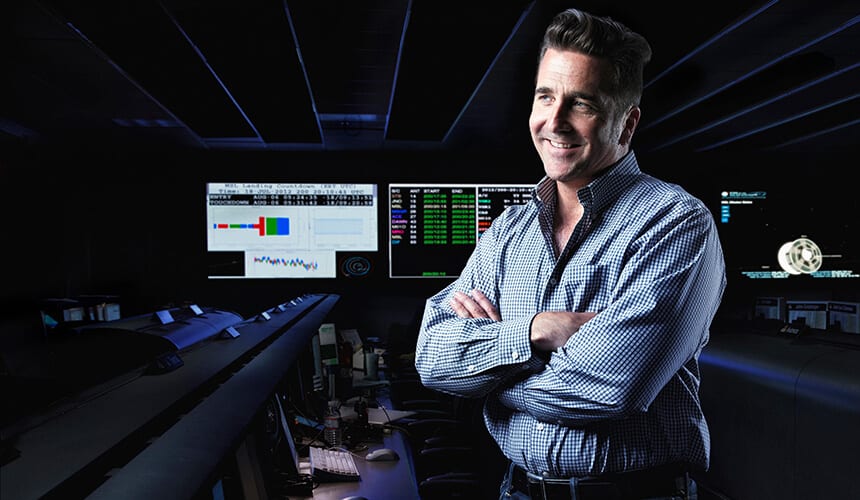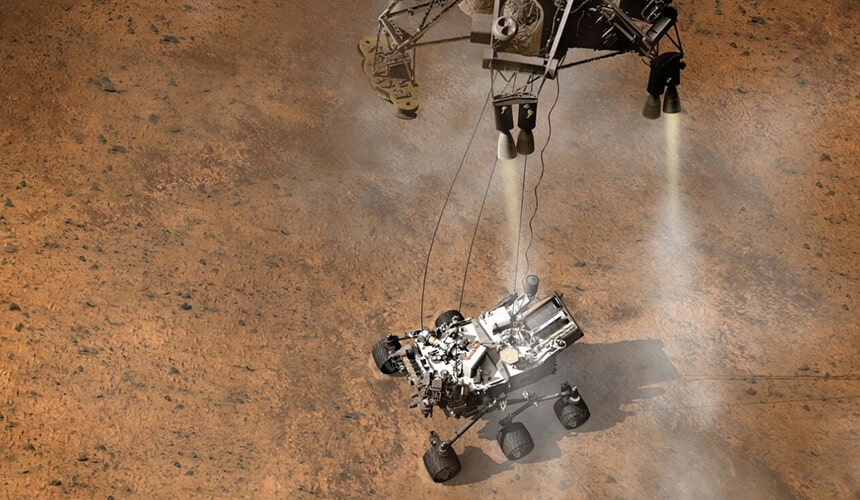Adam Steltzner
From Madison to Mars
Adam Steltzner PhD 1999 has been called a cross between Einstein and Elvis Costello — and that’s among the milder descriptions attached to the would-be rock star turned NASA engineer who led the team that landed the Curiosity rover on Mars in 2012.
His reputation is based mostly on his unusual path into space science. “I passed my [high school] geometry class the second time with an F plus, because the teacher just didn’t want to see me again,” he says of his early, lackluster academic performance.
Instead, Steltzner’s focus was on music. He played bass in rock bands around his hometown of San Francisco until one night in 1984, when he happened to look up at the stars and let his imagination wander. He noticed that the constellation Orion had moved in the few hours he’d been playing at a show, and he wondered why. More or less on a whim, he enrolled in a physics class at the local community college, and a year later, he returned to school full time, eventually earning degrees from the University of California–Davis and the California Institute of Technology.
Behind Steltzner’s Elvis-inspired haircut and snakeskin boots is a deeply inquisitive engineer with a passion for space exploration. In 1991, he started his first job at NASA’s Jet Propulsion Laboratory (JPL) as an analyst to test small portions of the Pathfinder project, among others. But he soon realized that he needed bigger challenges. “Despite my zeal for digging down and ferreting out the objective truth, I found that I was not super interested in the kind of engineering where the next problem looks just like the last one,” he says.
Steltzner commuted regularly to California to stay involved at JPL while pursuing his doctorate at the UW. After he returned to Pasadena full time, he was invited to the Curiosity team to lead the project that would become the biggest challenge of his career (so far).
For the next decade, Steltzner’s job was to lead Curiosity’s 50-person entry, descent, and landing (EDL) team, which had to come up with a way to bring the Mini Cooper–sized rover to the Martian surface without smashing it. Old methods wouldn’t work since Curiosity was bigger than its predecessors and would be landing in a rocky, uneven crater. From the time the rover entered the Martian atmosphere, it had only seven minutes to slow itself down from 13,000 miles per hour before crashing onto the surface.
“Ours is perhaps the most treacherous part of this incredibly complex mission, and definitely the most visible,” he wrote in his book about the project, Right Kind of Crazy: A True Story of Teamwork, Leadership, and High-Stakes Innovation. “Like a flaming guitar solo in a stadium concert, EDL might not be the mission’s most fundamental element, but it is the part that everyone will remember, good or bad, the next day.”
From The Park
As lead engineer on NASA’s Curiosity rover, Steltzner helped to expand the understanding and exploration of Mars. A maverick of space exploration, he later voiced his dream “to float a boat on the methane lakes of Titan.”
Source: Used by permission of copyright holder.
Watch an animation of the Curiosity Rover landing.
On August 6, 2012, after a radar glitch that put the entire team on edge for almost 72 hours, the rover landed successfully on Mars.
Listen to the last seconds in the mission control room before NASA learned the Curiosity Rover had successfully touched down on Mars. [media attached]
But like Curiosity itself, Steltzner’s work is far from over. He’s currently part of another Martian rover mission expected to launch in 2020, and he’s designing new technologies that could someday help humans both land and survive on the Red Planet.
“Curiosity is a spark, and exploration is the fire that burns from it,” he says.
Curiosity Rover Fast Facts
- Landed on Mars on August 6, 2012
- Weighs 1,982 pounds, about the size of a Mini Cooper car
- Required a 4,968-pound entry vehicle to deliver it to Mars, the size of a small SUV
- Traveled more than eight months at an average of 13,000 mph
- Landed in the Gale Crater, near Mount Sharp
- Investigates Martian climate and geology
- Found perchlorates (salts), which provided early evidence of water on Mars
Watch NASA’s “Seven Minutes of Terror” to hear Steltzner describe the tension before the Curiosity Rover successfully landed on Mars.
Watch Steltzner’s TED Talk about Mars and the Curiosity mission.
 48° F
48° F
